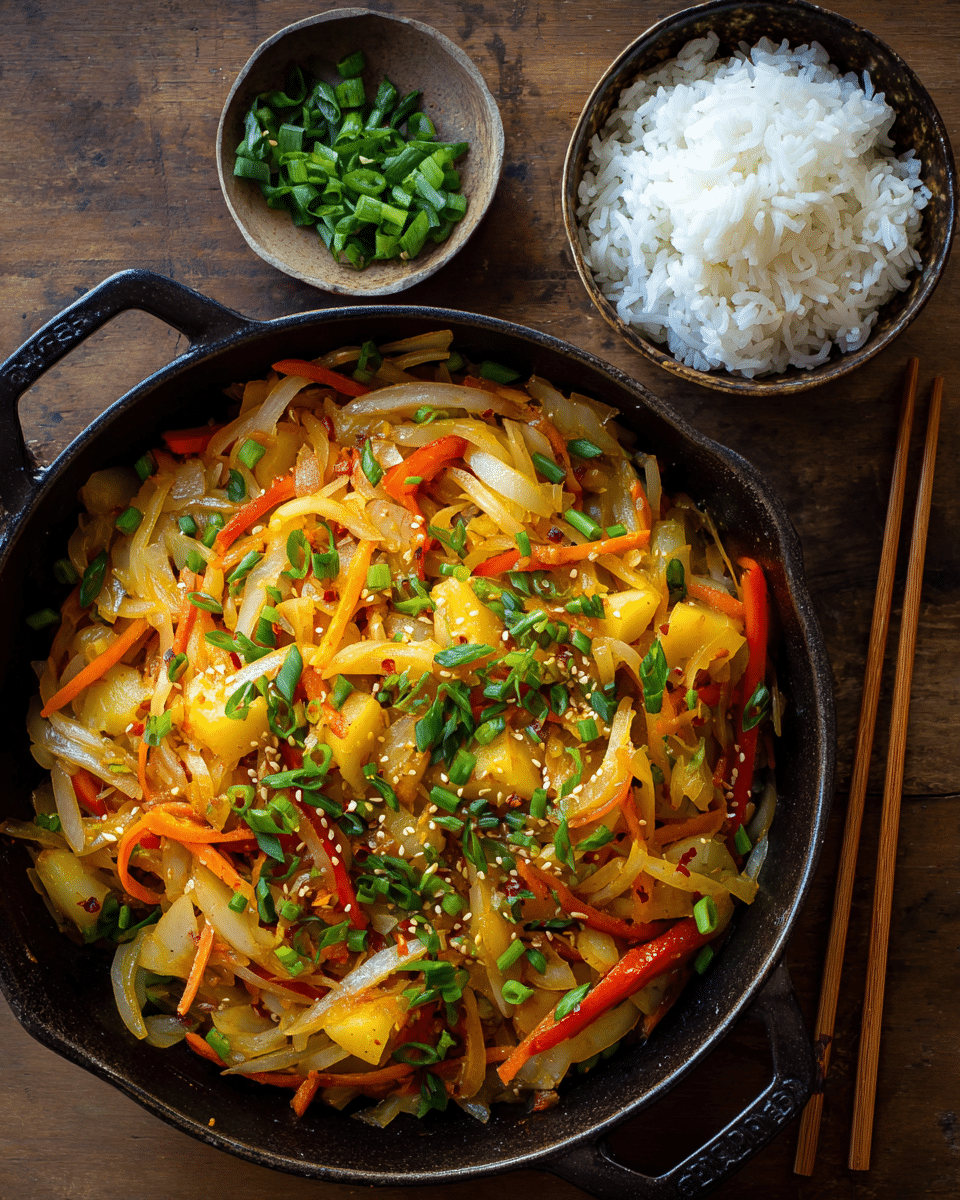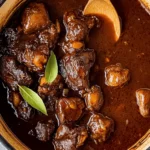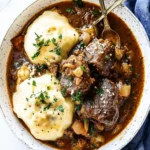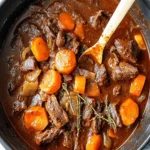Kohlrabi Stir-Fry is a vibrant and nutritious dish that brings out the crisp, slightly sweet flavor of this often-overlooked vegetable. Popular in both Eastern and Western cuisines, kohlrabi adds a refreshing crunch that pairs well with a medley of other vegetables and flavorful seasonings. This stir-fry is ideal for busy weeknights when you want a wholesome, plant-based meal that comes together in under 30 minutes.
FULL RECIPE
Ingredients
- 2 medium kohlrabi, peeled and julienned
- 1 small carrot, peeled and sliced into thin matchsticks
- ½ red bell pepper, sliced thin
- 1 small onion, thinly sliced
- 2 cloves garlic, minced
- 1-inch piece of ginger, minced
- 2 tablespoons soy sauce
- 1 tablespoon sesame oil
- 1 tablespoon vegetable oil (for stir-frying)
- 1 teaspoon rice vinegar or lemon juice
- ½ teaspoon red chili flakes (optional)
- Salt and black pepper to taste
- 1 tablespoon chopped green onions (for garnish)
- 1 teaspoon sesame seeds (optional, for garnish)
Directions
- Heat the vegetable oil in a large skillet or wok over medium-high heat.
- Add the sliced onion and sauté for 1–2 minutes until slightly softened.
- Stir in the garlic and ginger, and cook for another 30 seconds until fragrant.
- Add the kohlrabi, carrot, and bell pepper. Stir-fry for 4–6 minutes, stirring frequently, until the vegetables are tender-crisp.
- Drizzle in the soy sauce and sesame oil, then add rice vinegar or lemon juice and chili flakes (if using). Toss everything well to coat.
- Season with salt and pepper to taste. Stir-fry for another minute to blend flavors.
- Remove from heat. Garnish with chopped green onions and sesame seeds before serving.
- Serve hot as a main dish with steamed rice or as a side to a protein of your choice.
Nutrition Facts
- Calories: 120 kcal
- Carbohydrates: 12g
- Protein: 3g
- Fat: 7g
- Saturated Fat: 1g
- Cholesterol: 0mg
- Sodium: 480mg
- Fiber: 4g
- Sugar: 5g
- Vitamin A: 60% DV
- Vitamin C: 110% DV
- Calcium: 4% DV
- Iron: 6% DV
Nutritional Benefits of Kohlrabi
Kohlrabi is a low-calorie, high-fiber vegetable packed with essential nutrients. It is particularly rich in vitamin C, which boosts immunity and promotes healthy skin. Additionally, kohlrabi contains potassium, aiding in blood pressure regulation, and phytonutrients like glucosinolates that may have cancer-preventing properties. Its high water content makes it hydrating and refreshing, especially when lightly cooked. Incorporating kohlrabi into meals like stir-fries can support digestive health and weight management while keeping meals flavorful and satisfying.
Health Boost from Other Vegetables
This stir-fry often includes other nutrient-dense vegetables such as carrots, bell peppers, and onions, each contributing its own health advantages. Carrots are rich in beta-carotene for eye health, while bell peppers add vitamin A, antioxidants, and vibrant color. Onions provide quercetin, known for its anti-inflammatory properties. Together, these vegetables create a nutrient powerhouse that not only satisfies hunger but supports holistic wellness. The quick cooking method of stir-frying helps preserve many of these vitamins and minerals, enhancing their nutritional impact.
Quick Cooking for Busy Lifestyles
One of the key appeals of a kohlrabi stir-fry is its speed and simplicity. In under 30 minutes, you can have a well-balanced, flavorful meal ready for the table. The prep involves simple chopping and julienning, and the cooking process takes just minutes, making it ideal for weeknight dinners. It’s a smart option for those who want home-cooked meals without spending hours in the kitchen. This recipe is perfect for professionals, parents, and students who need a quick yet nutritious solution.
Flavor Profile and Aromatics
The success of this dish lies in the balance of umami-rich soy sauce, the nutty depth of sesame oil, and the aromatics like garlic and ginger. These ingredients create a flavor base that enhances kohlrabi’s natural sweetness without overshadowing it. Adding rice vinegar or lemon juice at the end introduces a bright acidity, cutting through the richness and rounding out the taste. Optional additions like chili flakes provide a subtle heat for those who enjoy a kick in their meals, offering a customizable flavor experience.
Versatility and Variations
One of the greatest strengths of this recipe is its adaptability. You can easily add tofu, tempeh, or seitan for a plant-based protein boost. For non-vegetarian versions, thinly sliced chicken, shrimp, or beef work seamlessly. The vegetable mix is also flexible—broccoli, snap peas, or mushrooms can be tossed in depending on what you have on hand. You can even swap the soy sauce for tamari to make the dish gluten-free, or use coconut aminos for a lower-sodium alternative. This versatility keeps the recipe fresh and interesting meal after meal.
Best Pairings for a Complete Meal
Kohlrabi stir-fry pairs beautifully with steamed jasmine or basmati rice, which soak up the savory sauces. For a more fiber-rich alternative, try serving it with quinoa or brown rice. It also complements rice noodles or soba noodles for a more filling Asian-inspired meal. As a side, this stir-fry adds a healthy crunch next to grilled meats or dumplings. A miso soup or cucumber salad can round out the meal, enhancing both texture and nutritional variety while maintaining a cohesive flavor theme.
Storage and Meal Prep Tips
This dish is excellent for meal prep, as it stores well in the refrigerator for up to four days. Allow the stir-fry to cool completely before transferring it into airtight containers. Reheat gently in a pan or microwave, adding a splash of water or soy sauce to revive the texture and flavor. The kohlrabi retains a good amount of its crunch, even after refrigeration. For best results, avoid freezing as the vegetable’s water content may lead to sogginess upon thawing.
Kid-Friendly and Beginner-Approved
The mild flavor and fun texture of kohlrabi make it a surprisingly appealing vegetable for children. Its resemblance to familiar foods like apples or jicama when sliced thin can help overcome picky eating habits. For extra kid-friendliness, the spice level can be toned down and a drizzle of honey or a dash of hoisin sauce added to boost sweetness. The recipe is also a great entry point for beginner cooks, as it involves basic knife skills and straightforward cooking steps with minimal risk of overcooking.
Environmental and Seasonal Benefits
Kohlrabi is often available in cooler seasons and is a great option for those looking to cook with seasonal produce. Buying it fresh from local farmers’ markets supports sustainable agriculture and reduces your carbon footprint. It’s a hardy vegetable that stores well, minimizing food waste. Additionally, using the leaves of the kohlrabi in stir-fries or soups adds value and reduces unnecessary discard, making it a zero-waste choice for eco-conscious cooks.
Advertisement
Conclusion
Kohlrabi Stir-Fry is a standout dish that combines health, flavor, and convenience in one vibrant pan. It showcases the unique qualities of kohlrabi while embracing a medley of colorful vegetables and bold seasonings. Whether you’re cooking for health, speed, or simply to try something new, this recipe offers flexibility and satisfaction. Its versatility, nutritional benefits, and ease of preparation make it a staple for busy kitchens and health-conscious households alike. With the right pairings and a few personal touches, Kohlrabi Stir-Fry can become a beloved part of your weekly meal rotation.






